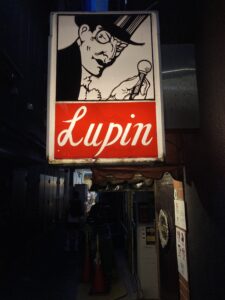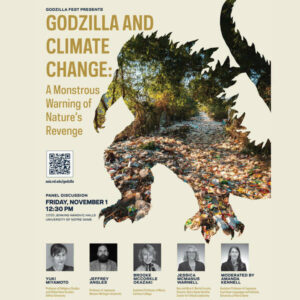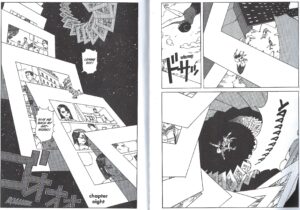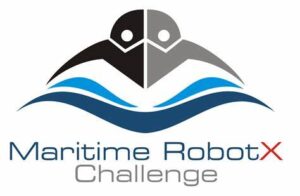As anticipated, Notre Dame has kept me busy this past year! So busy, in fact, that I need to begin this round-up with an interview from October of last year, with the Idol Cast. The music-focused Idol Cast has a rather unique approach to podcasting: each episode features musical interludes and is packaged with embedded music videos so that listeners can hear and see the cool stuff discussed in the podcast.
January began with another interview: Jingyi Li, my colleague at the New Books Network, discussed Alice in Japanese Wonderlands with me. I am grateful to Jingyi – who is an incredibly experienced interviewer on top of being a formidable scholar – for both the invitation and her skillful questioning.
In between presenting my research at the Association of Asian Studies conference in March and the Midwest Conference on Asian Affairs in September, I was honored to speak to a full house at Otakon by the invitation of the Embassy of Japan’s Japan Information and Culture Center. First Otakon and then JICC nurtured my interest in Japan when I was young, so it was truly moving to be able to contribute a bit to their illustrious traditions. My talk, “Japanese Technology and Anime in the ’90s,” brought together my work on Alice in Wonderland with my work in the digital humanities.
 That same digital humanities work moved forward in two ways this year, one planned, the other an unexpected joy. First, I was finally able to get my teeth into a project that has been occupying the back of my mind while I finished my book over the past few years. Basically, there seems to have been a shift in how we experience the world around us, which I think is due at least in part to the digitization of our media and how those media direct our attention. A grant from the Liu Institute for Asia and Asian Studies sent me to Japan this summer to begin conducting research on the ground. That led to the MCAA conference presentation that I mentioned above, “Drinking with Dazai at Bungo Stray Dogs’ Bar Lupin.” I am now expanding that paper for further feedback and eventual publication as the first research output for this new project.
That same digital humanities work moved forward in two ways this year, one planned, the other an unexpected joy. First, I was finally able to get my teeth into a project that has been occupying the back of my mind while I finished my book over the past few years. Basically, there seems to have been a shift in how we experience the world around us, which I think is due at least in part to the digitization of our media and how those media direct our attention. A grant from the Liu Institute for Asia and Asian Studies sent me to Japan this summer to begin conducting research on the ground. That led to the MCAA conference presentation that I mentioned above, “Drinking with Dazai at Bungo Stray Dogs’ Bar Lupin.” I am now expanding that paper for further feedback and eventual publication as the first research output for this new project.
 Even as I was speeding into this new project, the Liu Institute kindly invited me to work on a series of events in honor of Godzilla‘s 70th anniversary. Godzilla Fest was a wonderful experience from first to last, but the panel discussion “Godzilla and Climate Change: A Monstrous Warning of Nature’s Revenge” was particularly important in my eyes. Drs. Yuki Miyamoto, Jeffrey Angles, Brooke McCorkle Okazaki, and Jessica McManus Warnell eloquently tied a geriatric movie monster to contemporary culture and absolutely vital nuclear issues.
Even as I was speeding into this new project, the Liu Institute kindly invited me to work on a series of events in honor of Godzilla‘s 70th anniversary. Godzilla Fest was a wonderful experience from first to last, but the panel discussion “Godzilla and Climate Change: A Monstrous Warning of Nature’s Revenge” was particularly important in my eyes. Drs. Yuki Miyamoto, Jeffrey Angles, Brooke McCorkle Okazaki, and Jessica McManus Warnell eloquently tied a geriatric movie monster to contemporary culture and absolutely vital nuclear issues.
Dr. McManus Warnell partnered with me after the event to write about the same issues for the Conversation, a website that helps scholars package our work for general audiences. Our article has been read over 8,000 times and republished in almost a dozen other venues! Based on that work, I was interviewed by Shaye Ganam for his QR Calgary radio show. The enthusiasm that met these projects has encouraged me to consider taking this work further too, perhaps as part of my media/environment project.
2024 was incredibly busy – I also judged the website and video entries of RobotX’s 2024 competition, interviewed Mimi Okabe about her new book, Manga, Murder, and Mystery, taught new and revised courses, and began expanding my knowledge of database software in an attempt to improve my research. May the new year hold more of the same.
A final note: I’ve never been a huge Tweet-er, and I would prefer not to deal with whatever mess Elon Musk joining the government will deal to those of us who regularly have to explain our governmental connections on grant applications. I need to hold onto my Twitter account for research reasons for a while, but you will only find me posting on Bluesky now. My handle is akennell.
Apologies for the long wait and longer post. 2025 is already shaping up to be just as busy as 2024, but I’ll try to update here more regularly. May you and yours have a Happy New Year!




